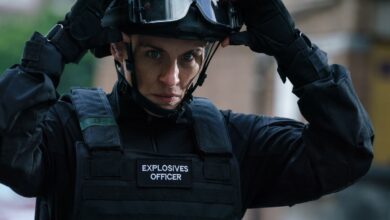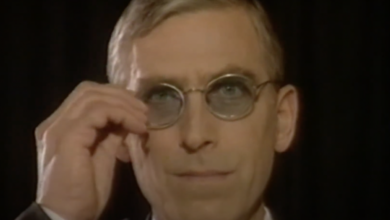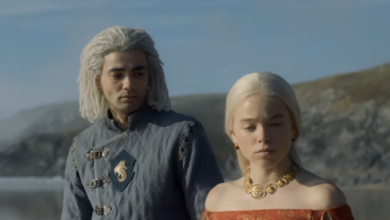Jane Seymour: ‘I’m so fed up of hearing, should a woman be Bond?’

Dig deep into Jane Seymour’s carefully curated wardrobe of museum-quality vintage clothing and, in among the 17th-century frock coats beloved by Princess Margaret and dazzling Halston gowns, you’ll find a box full of hair. Barely touched since Seymour starred in the dizzyingly popular 1990s series Dr Quinn, Medicine Woman, her pioneer-era wigs were last month treated to a long-overdue night out at the Oscars. “They usually sit in a nice little Tupperware box,” says Seymour of the iconic hairpieces. “But my hairdresser said, ‘Let me do something different – those Dr Quinn wigs, I want to get my hands on those!’ Dr Quinn only wore one at a time, but he put both on me. It was a mountain of hair!”
We’re here to discuss her new TV series, Harry Wild – more on which later – but inevitably conversation veers towards the Oscars. It’s just 36 hours on from the most eventful Academy Awards of the century when Seymour speaks to me from her Malibu mansion, but this consummate pro is taking the scandal in her stride. The 71-year-old stage and screen veteran is smiley and chatty; Hollywood anecdotes tumble out of her.
She has seen Oscars drama before. In 1981, she presented an award to Raging Bull alongside comedian Richard Pryor, the same year the ceremony was postponed due to the attempted assassination of President Ronald Reagan. “I remember that year very distinctly,” says Seymour, who at the time was starring on Broadway in a Tony-winning production of Amadeus with Tim Curry and Ian McKellen, almost a decade on from her breakthrough turn in Live and Let Die as Solitaire – a fortune-teller who is almost sacrificed at a “voodoo” ceremony, making her one of the more problematic Bond women in possibly the most problematic Bond film of all. Hair was important at that year’s Oscars ceremony, too. “I’d been criticised as looking like I had 50 pounds of mildewed mattress-stuffing on my head,” remembers Seymour of her outrageous perm, which went on to set the flamboyant follicular tone for the rest of the Eighties, with Dolly Parton and Whitney Houston – even Ozzy Osbourne – all following suit.
This year, Seymour watched the ceremony at Elton John’s party, on a table with Rosanna Arquette and her sister Patricia – who’s currently terrifying viewers in Apple TV+’s Severance – as well as Mad Men’s Christina Hendricks. When the big Will Smith moment happened “everyone went very quiet”, says Seymour. “It was like, ‘What?! Was that for real? Was that a joke? What are they going to do about this? Are they going to ask him to leave?” Instead of staying to find out, Seymour decided to make a break for it and headed to the Vanity Fair bash. “I thought, ‘Well, I’ll just slide out of here when no one’s noticing’. But anyway, I’m happy to say that it’s resolved and it’s no longer an international crisis!”
Slapgate aside, this year’s Academy Awards included a high-octane compilation tribute to 60 years of Bond. “They were playing my song, ‘Live and Let Die’, so I got all excited!” says Seymour. “And I’m watching, watching, watching – but I’m not in it! My son Sean was very upset about that.” Mixing good old-fashioned misogyny with a very uncomfortable take on the Blaxploitation genre, the film nonetheless catapulted a 22-year-old Seymour to global fame. “‘Wow, you would never make that film now!’” thought Seymour when she last rewatched the 1973 classic, in which she stars alongside Roger Moore. “My character is a virgin, and she has superpowers, because of her virginity, to read the future with tarot cards,” reflects Seymour on the dated trope, which equates female purity with female worth. “Then, once Bond has had her, she’s lost that and therefore she’s no longer useful to anyone. She is discarded.”
When it comes to what the future might hold for James Bond in a post-Daniel Craig world, fan theories don’t come much spicier than the one Seymour has just dreamt up. “It occurred to me today, because I’m so fed up of hearing ‘Should a woman be Bond?’, that I would be very happy to be in a Bond film, and I know exactly what I would play,” says Seymour, a sparkle in her eye. “We don’t know what happened to Solitaire, do we? When she lost her virginity, is it possible she got pregnant? Is it possible she went on to be a grandma? And is it possible that her grandchild has her abilities?” Either way, Seymour will be watching the next instalment, whether or not she’s involved. “Bond gets better and better, and it’s more in tune with today’s feelings and thoughts and issues,” she adds. “It was far more comedic when I did it – it’s become much more of an adventure.”
Though Seymour has never won an Oscar herself – despite having a couple of Golden Globes and an Emmy to her name – in 2006, a film she was involved with from its very inception received five nominations. It’s a little-known fact that Johnny Cash biopic Walk the Line had its roots in a 1993 episode of Dr Quinn, on which Cash guest-starred. Seymour’s fourth husband James Keach was directing the show, and the couple became firm friends with Cash and his wife June Carter. “Johnny was in a lot of pain at the time,” remembers Seymour. “He’d had some very bad dental surgery and was in really bad shape, and James and I, we nurtured him through it.” Despite his health issues, Cash revelled in his spot on the sprightly Old West television drama. “He was so grateful for the experience, and loved it so much, that he and June asked us to make a movie of his life.”
Seymour and Keach got to work straight away, undertaking lengthy and intimate interviews with the country music greats, living with the pair for a time in Hendersonville, Tennessee, and joining them at their holiday home in Jamaica. “We really became family,” says Seymour, who remained close to Cash and Carter until their deaths in 2003. “We had our own room at their house. I remember saying to Johnny, ‘What really is going to make this film work is if you tell me the gnarly truth’,” says Seymour. As such, the resulting screenplay dug not only into the good times, but into the darkness, drugs and infidelity. However, despite his best efforts, Keach was unable to get the film greenlit. In the end, director James Mangold, of 1999’s Girl, Interrupted, took over the project, and Keach was given a producer credit, but not Seymour. “Even though I worked on it for nine years,” she says with a shrug. “You can only have so many producers.”
Seymour steps back in front of the camera for her latest project, Harry Wild, a jolly confection of a crime show in which she plays a rather revolutionary lead – that of a foul-mouthed retired English literature lecturer who’s fond of snogging, sexting and smoking. “I read it and went, ‘I have never seen this character or this show,’” she says. “It’s very hard to do something that’s unique, and as we know, there’s a tendency now for people to replicate something that was a success before or make a different version of it, but this was quite different.”
Originally set in Cambridge, the whole production was transported to Dublin to fit into a tight pandemic shooting schedule. In the first episode, Seymour’s Harry – short for Harriet – does shots and seduces university staff before asking her son’s teenage daughter for weed and then getting “s***faced”. When, I ask the poised Seymour, did she last find herself in such a position? “Once in my life!” she reveals. “I was with my ex-husband, and his idea of fun was to see how many margaritas he could get down me. I was absolutely fine until I got up… The room was swaying. The floor was uneven. The lights were moving, and I just about made it to the door. I don’t like being drunk, and so I’m never drunk. I do like my wine and champagne, but I’m very lucky, I have a sort of automatic stop switch.”
Despite living in California, where recreational marijuana is legal, Seymour is unlikely ever to be found stoned. “I have tried it, but weed and I don’t get along either,” she recalls unfondly. “I remember being incapable of stopping eating. I had to eat everything in sight. I don’t like being out of control – but I can play it. In Euphoria, apparently Zendaya has never had a drug in her life, and she was very convincing.”
Yet life in California has other benefits that Seymour is perfectly happy to take advantage of. She flips her laptop round to show me the breathtaking view from her balcony. “I’m watching pelicans and dolphins and whales and sunshine,” she beams. “A few palm trees, too. It’s very enticing.” It’s easy to see why Seymour left the UK for good in 1976, making her name in popular BBC drama The Onedin Line, and as a Bond girl, before joining what she calls “the first British invasion”.
Born Joyce Frankenberg in the west London suburb of Uxbridge to a Dutch protestant mother who worked as a nurse and a gynaecologist father with Jewish family roots in Poland, Seymour had to put her dreams of becoming a professional ballet dancer on hold when she became a working actor at the age of 13. Unlike the scholarly Harry Wild, she didn’t officially attend university. Instead, she had something of an ad-hoc education at Sussex University, where her first husband Michael Attenborough – son of director Richard Attenborough, whose 1969 film Oh! What a Lovely War Seymour appeared in as a chorus girl – was studying. “A lot of kids did not show up to lectures because they were too high or too drunk or too lazy, so I just snuck in the back,” she confesses. After appearing in a play alongside Sinéad Cusack at Sussex’s Gardner Arts Centre, she was found out when a professor approached her in the bar and asked if she was in his class. “I told him the truth,” admits Seymour. “He said ‘Look, I’m just happy to have the company!’”
As well as Harry Wild, we’ll also get to see Seymour on the big screen later this year, when she plays an Australian woman with dementia in the emotive Ruby’s Choice. “My kids find it hard to watch,” she reveals. “They’ve said, ‘It’s too real, mum.’ Every time I can’t find my phone, or I’ve forgotten whether I took my vitamins in the morning, they look in horror at me, like, ‘No mum, please don’t’.”
While preparing for the part, Seymour drew on her experience with another country music legend: Glen Campbell, with whom she had worked on the 2014 documentary I’ll Be Me. Directed by James Keach – in the same year that the couple separated – the film follows the “Wichita Lineman” singer on his final tour after being diagnosed with Alzheimer’s. “At first we thought, that’s gonna be a very depressing movie, and then we realised that he talked like Donald Duck and was hilarious and brilliantly talented,” says Seymour. During the making of the movie, Seymour and Keach accompanied Campbell to Congress and met with Nancy Pelosi to discuss funding for Alzheimer’s research.
Seymour as the titular ‘Dr Quinn, Medicine Woman’
Despite his declining condition, Campbell was committed to playing live. “We were hoping he could do one or two concerts – he did 140,” says Seymour with a smile. “He was live at the Grammys – he didn’t even know where he was, and we push him on stage, he heard the music, and ‘Oh! “Rhinestone Cowboy”, I know that!’ It was the most amazing experience.”
As special moments at awards ceremonies go, it’s occasions like this that put this year’s Oscars drama into perspective. “It was the most amazing experience,” says Seymour, and with a flick of her hair, she’s off to admire that glorious Malibu view.
‘Harry Wild’ is on Acorn TV now
Weed and I don’t get along – I remember being incapable of stopping eating
Seymour and Rohan Nedd in ‘Harry Wild’





